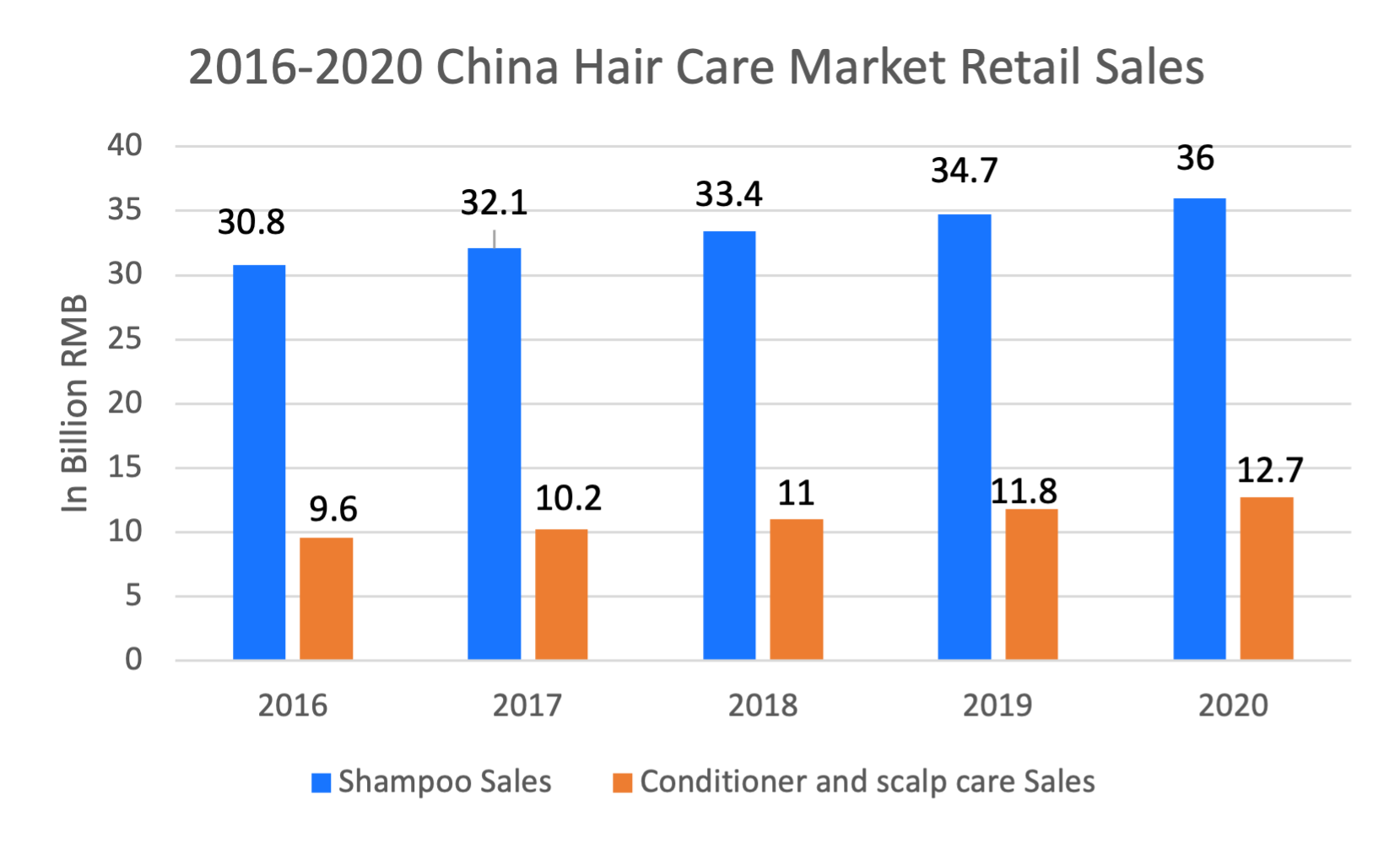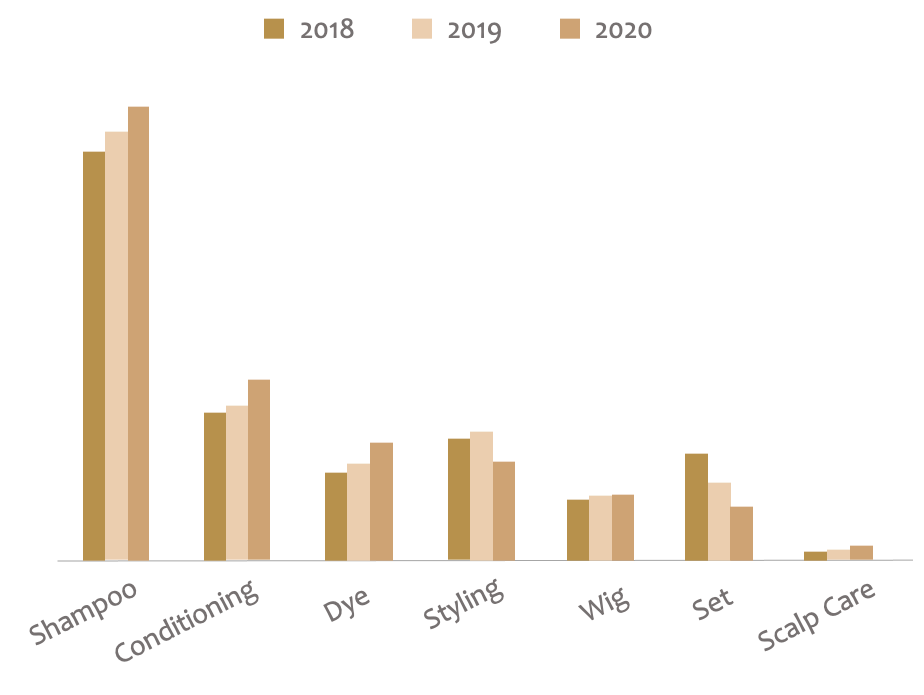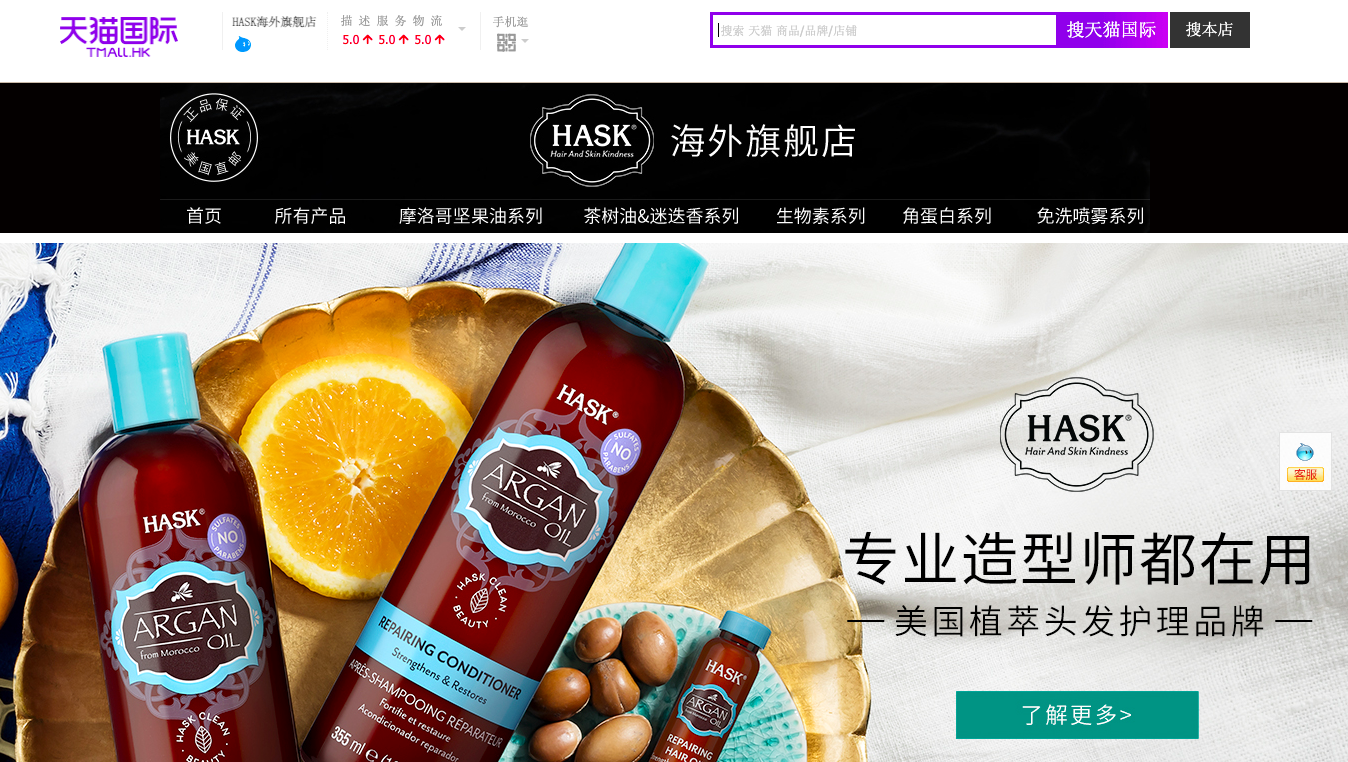The Uprising Haircare Market in China
by Queenie Yao
The haircare market in China is booming
As a daily consumer product, the haircare market in China has massive headroom for brands to grow. The overall Chinese haircare market gained a steady growth rate of 4.8% in 2020, tapping a market size of 48.7 billion RMB[1], Mintel predicts. The latest research by Mintel presents that 94%[2] of Chinese consumers reckon that scalp care is as essential as skincare.
China's shampoo and haircare market is experiencing steady and sustained growth and is expected to reach RMB60.5 billion by 2025. The rapid increase in consumption of haircare products is driven by rising awareness on specific haircare issues and vertical category, and the consumption upgrade trends in China.

![]()
Source: Mintel Haircare Market Research
The study from Mintel showed that Shampoo is still the largest segment in the hair care consumer market, which is used by Chinese consumers daily. It is a highly demanded and also highly competed product category. Conditioner and scalp care products, sales are much smaller than Shampoo, but the growth rate of these product segments is 2-fold that Shampoo. In the future, we predict that conditioner and scalp care will be the main driver of the industry's retail sales growth.
Claims blurred from skincare categories are widely accepted
The concepts and trends that continue to migrate from the popular skincare market have accelerated the upgrading of care functions and consumers' increasing awareness of scalp health. Witnessed top-rated claims in skincare are migrating to hair care, which related to hair care products also reflect the purchasing needs of consumers.
Cleansing as the basic function is still the top demand, but more people are starting to care about damaged hair repair (37%) and expanded functions such as repairing, color-treated hair, and scalp care.
Interestingly, consumers prefer to care claims such as anti-oxidant, vitamins&minerals, and probiotics, which make up 4%, 11%, and 2% in 2020, respectively, Mintel states. Using ingredients that claim to bring effects from skincare to scalp care is rising, as customers demand clarity on the ingredients used in shampoo, targeted treatment, and evolving function demands.
The emerging haircare demands from conditioner and oil products are gaining attention among emerging claims, including anti-dandruff, dandruff prevention, and scalp problems. Consumer's evolving concern on scalp problems reflects a significant demand solution of scalp care solutions. Unlike a decade past, Chinese consumers treat dandruff by deep-cleansing. They are now increasingly aware that the root cause of dandruff is unhealthy scalp conditions. More and more consumers believe that scalp care is as crucial as skincare.
With hair perm and dye become a norm for the younger generation of consumers, there is also a considerable increase in hair damage repair and color treatment. Consumers are no longer satisfied with the traditional claim and look for targeted treatment delivered by ingredients such as keratin, amino acid, and essence oil.
Market segmentation of China's haircare market: highly demanding products
The figure released by Tmall presented that Tmall B2C Retail sales of Hair Care have two years of consecutive growth above 30% per annum. With customers tend to choose high quality, targeted functions, or high value-added products. This also means new players and more competition.

2018-2020 Tmall Haircare product penetration by type. Source: Tmall
The Shampoo has one of the highest penetration rates of personal care products in China. Shampoo is undoubtedly the highest demanded category, attracting most hair care brands and intensive competition.
Penetration rates of hair care, dye & perm, and scalp care are also growing stably. Conditioning growth in 2020 is even higher than Shampoo, the Tmall Haircare Market Report highlight. With diversifying needs increase, customers will spend more on scalp care. This is a tremendous categorical opportunity.
Other products such as styling and sets also have enormous scale, but the overall penetration is decreasing. The drop can be seen in set products especially. Customers have more precise demands regarding what they want, and they are proactively choosing products instead of accepting a 'hard sale' from the merchant.
What are the opportunities in China's haircare market?
The trending search terms on popular social media platforms revealed that Chinese consumers have a strong demand for anti-dandruff, oil control, hair growth, and itching in the shampoo category. Coconut flavor, orange blossom, fluffy, hair follicle, ocean, hair loss prevention, and nourishing have become new hot spots for shampooing. And the needs of caffeine, hair stabilization, hair growth, color lock, color protection, silicone oil-free, etc., are also niche demands.
Repairing dryness and softening frizz are still the two major hair care needs. Static-free, correction, and recovery have become fast-growing new search terms. Perm, moisturizing, curling, fluffy, and essential oils are the second high-growth keywords.

Tmall Trending Search Terms 2020-2021.2 Source: Tmall, CBN Data
Chinese consumers are willing to try new things, whether it comes to change products or trust new brands. According to Mintel's survey, 66% of the respondents said they don't like using haircare products. Notably, young consumers aged 25 to 39-year-old are the major explorers. 67% of Chinese consumers consider the target hair problem the most important reason to try new products and brands.
Chinese consumers' appetite for new products is driven by benefits, especially in resolving their pain points, including hair problems and conditions. Such a mindset is similar to the effectiveness-led skincare market to some extent. Consumers are still discovering the best solutions that work, and they're open to trying niche imported brands. This also revealed an ongoing trend for consumers to look for high-end products that deliver better treatment or luxury fragrances.
HASK Beauty, a brand that stands for Hair and Skin Kindness launched via Tmall Global in July 2021 to capture the uprising market demand for essence treatment and scalp care.

HASK Beauty's Tmall Global Flagship Store
Kerastase, a premium haircare brand owned by L'Oreal, is the successor to China's haircare market. The brand has been in the market for many years, becoming popular among Chinese consumers through cross-border e-commerce business. Witnessed the colossal success, Karastase then entered China market through general trade and launched its Tmall flagship store. The brand can stock a large inventory in mainland China warehouses to meet local consumer demands and shorten shipping times with general trade. Now, the Kerastase Tmall store boasters nearly 4 million fans.
Haircare is becoming a category where consumers pursue more and more quality, and we see the premiumization remains an opportunity. Another prestige haircare Oribe (now owned by Kao) is launching its official Tmall Global flagship store and has over 2000 shop followers.
Cross-border e-commerce provides a shortcut to give DTC brands access to the Chinese market. DTC brands firstly build their sales channels through platforms such as Tmall Global and JD Worldwide, since brands rely on the customers of these platforms to get to know the brand and make the purchase. While digital marketing in sales channels can effectively drive sales, marketing in China does not stop at the marketplaces. For DTC brands, leveraging social media platforms to grow brand awareness is essential to make the best possible move in China.
[1] Mintel: Skincare' concepts take root in China's haircare market, 2021; URL
[2] Mintel: Consumer Report: Haircare in China, 2021; URL